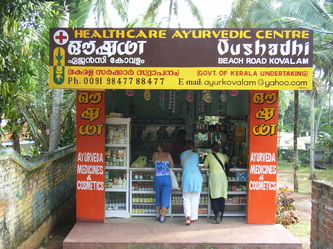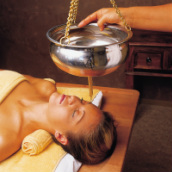Ayurveda in Kovalam
You will find an abundance of Ayurveda Treatment Centers, practitioners and hospitals all over Kovalam and its environs. It seems that everyone makes his/her own experience with the ayurveda-docs, so it is very hard to recommend the "right" one. Ayurveda is very personal, a lot depends on the chemistry between the practitioner and the patient. We are happy to share our experience with our visitors, please contact us with your specific needs.
About Ayurveda
Ayurvedic medicine is one of the world’s oldest medical systems. It originated in India and has evolved there over thousands of years.
Ayurvedic medicine, also called Ayurveda, originated in India several thousand years ago. The term “Ayurveda” combines the Sanskrit words ayur (life) and veda (science or knowledge). Thus, Ayurveda means “the science of life.”
Ayurvedic medicine aims to integrate and balance the body, mind, and spirit; thus, some view it as “holistic.” This balance is believed to lead to happiness and health, and to help prevent illness. Ayurvedic medicine also treats specific physical and mental health problems. A chief aim of Ayurvedic practices is to cleanse the body of substances that can cause disease, thus helping to reestablish harmony and balance.
Key Points
Most major cities in India have an Ayurvedic college and hospital. The Indian government began systematic research on Ayurvedic practices in 1969, and that work continues.
Learn more about Ayurveda:
wikipedia
the ayurvedic institute
ayurvedic foundation
mother ayurveda
Ayurvedic medicine, also called Ayurveda, originated in India several thousand years ago. The term “Ayurveda” combines the Sanskrit words ayur (life) and veda (science or knowledge). Thus, Ayurveda means “the science of life.”
Ayurvedic medicine aims to integrate and balance the body, mind, and spirit; thus, some view it as “holistic.” This balance is believed to lead to happiness and health, and to help prevent illness. Ayurvedic medicine also treats specific physical and mental health problems. A chief aim of Ayurvedic practices is to cleanse the body of substances that can cause disease, thus helping to reestablish harmony and balance.
Key Points
- The aim of Ayurvedic medicine is to integrate and balance the body, mind, and spirit. This is believed to help prevent illness and promote wellness.
- Ayurvedic medicine uses a variety of products and techniques to cleanse the body and restore balance. Some of these products may be harmful if used improperly or without the direction of a trained practitioner. for example, some herbs can cause side effects or interact with conventional medicines.
- Before using Ayurvedic treatment, ask about the practitioner’s training and experience.
- Internal medicine
- Surgery
- Treatment of head and neck disease
- Gynecology, obstetrics, and pediatrics
- Toxicology
- Psychiatry
- Care of the elderly and rejuvenation
- Sexual vitality.
Most major cities in India have an Ayurvedic college and hospital. The Indian government began systematic research on Ayurvedic practices in 1969, and that work continues.
Learn more about Ayurveda:
wikipedia
the ayurvedic institute
ayurvedic foundation
mother ayurveda




